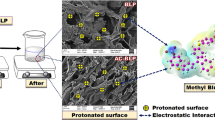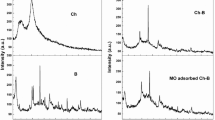Abstract
Bentonite from the Birjand area of Iran was characterized by X-ray diffraction, X-ray fluorescence, and Fourier transform infrared spectroscopy. The removal of cadmium from aqueous solution by this bentonite was investigated as a function of conditions such as contact time, metal concentrations, pH, stirring speed, temperature, particle size, and amount of bentonite. The adsorption isotherm was studied with different models: the Freundlich and Dubinin–Radushkevich models had the highest correlation coefficients, 0.9922 and 0.9988, respectively. The corresponding Langmuir model indicates a maximum adsorption capacity of 13.50 mg/g. First-order, pseudo-second-order, and intra-particle diffusion equations were used to study the mechanism of adsorption; the experimental data fit well with pseudo-second-order kinetics. Thermodynamic parameters of adsorption were calculated at temperatures of 293, 303, 313, and 323 K, and indicated that the Cd adsorption was exothermic and spontaneous.
Zusammenfassung
Ein Bentonit aus der Region Birjand/Iran wurde mittels XRD, XRF und FTIR-Spektroskopie charakterisiert. Die Entfernung von Cadmium aus aquatischen Lösungen unter Verwendung dieses Bentonits wurde in Abhängigkeit von der Kontaktzeit, der Metallkonzentration, dem pH-Wert, der Rührgeschwindigkeit, der Temperatur, der Partikelgröße und der Menge des Bentonits untersucht. Für die Adsorptionsisotherme wurden verschiedene Modelle geprüft: Die Modelle nach Freundlich und Dubinin-Radushkevich (D-R) wiesen mit 0,9922 bzw. 0,9988 die höchsten Korrelationskoeffizienten auf. Das korrespondierende Langmuir-Modell ermittelt dazu eine maximale Adsorptionskapazität von 13,5 mg/g. Um den Adsorptionsmechanismus zu beschreiben, wurden Gleichungen erster Ordnung, pseudo-zweiter Ordnung und zur intrapartikulären Diffusion verwendet. Die Ergebnisse passen gut zu einer Kinetik pseudo-zweiter Ordnung. Für Temperaturen von 293, 303 und 323 K wurden thermodynamische Adsorptionsparameter ermittelt. Sie zeigen, dass die Adsorption von Cd exotherm und spontan abläuft.
Resumen
Bentonitas de la región Birjand de Irán fueron caracterizadas por XRD, XRF y espectroscopía FTIR. Se investigó la remoción de cadmio desde soluciones acuosas usando esta bentonita como una función de condiciones tales como tiempo de contacto, concentraciones metálicas, pH, velocidad de agitación, temperatura, tamaño de partícula y cantidad de bentonita. La isoterma de adsorción fue estudiada usando diferentes modelos: los modelos de Freundlich y Dubinin-Radushkevich (D-R) tuvieron los mayores coeficientes de correlación: 0,9922 y 0.9988 respectivamente. El modelo de Langmuir indica una capacidad máxima de adsorción de 13,50 mg/g. Las ecuaciones de primer orden, seudo segundo orden y de difusión intra-partícula fueron usadas para estudiar el mecanismo de adsorción; los datos experimentales ajustaron mejor con la cinética de seudo segundo orden. Los parámetros termodinámicos de adsorción fueron calculados a las temperaturas de 293, 303, 313 y 323K indicando que la adsorción de Cd fue exotérmica y espontánea.
摘要
利用X射线衍射、X射线荧光光谱、傅氏转换红外线光谱仪等方法分析了伊朗Birjand地区的膨润土特征。研究了反应时间、镉浓度、pH、搅拌速度、温度、颗粒大小、膨润土投加量等不同条件对膨润土去除水中镉的影响。对比研究了不同类型等温吸附方程;其中,弗里德里希(Freundlich)方程和D-R(Dubinin-Radushkevich)方程相关系数最高,分别是0.9922和0.9988,而朗格缪尔(Langmuir)方程表明该膨润土的饱和吸附量是13.50 mg/g。分别采用一阶方程、准二阶方程和内扩散方程研究了膨润土的镉吸附机理,试验数据比较符合准二阶动力学方程。计算了温度分别为293K、303K、313K和323K时的吸附热力学参数,结果表明镉的吸附反应是放热、能自发进行的。





Similar content being viewed by others
References
Abollino O, Aceto M, Malandrino M, Sarzanini C, Mentasti E (2003) Adsorption of heavy metals on Na-montmorillonite. Effect of pH and organic substances. Water Res 37(7):1619–1627. doi:10.1016/S0043-1354(02)00524-9
Andini S, Cioffi R, Montagnaro F, Pisciotta F, Santoro L (2006) Simultaneous adsorption of chlorophenol and heavy metal ions on organophilic bentonite. Appl Clay Sci 31:126–133
Babel S, Kurniawan TA (2003) Low-cost adsorbents for heavy metals uptake from contaminated water: a review. J Hazard Mater 97(1–3):219–243. doi:10.1016/S0304-3894(02)00263-7
Bedoui K, Bekri-Abbes I, Srasra E (2008) Removal of cadmium (II) from aqueous solution using pure smectite and Lewatite S 100: the effect of time and metal concentration. Desalination 223(1–3):269–273. doi:10.1016/j.desal.2007.02.078
Bektaş N, Ağım BA, Kara S (2004) Kinetic and equilibrium studies in removing lead ions from aqueous solutions by natural sepiolite. J Hazard Mater 112(1–2):115–122. doi:10.1016/j.jhazmat.2004.04.015
Bentouami A, Ouali MS (2006) Cadmium removal from aqueous solutions by hydroxy-8 quinoleine intercalated bentonite. J Colloid Interf Sci 293(2):270–277. doi:10.1016/j.jcis.2005.06.040
Bulut E, Özacar M, Şengil İA (2008a) Adsorption of malachite green onto bentonite: equilibrium and kinetic studies and process design. Microporous Mesoporous Mater 115(3):234–246. doi:10.1016/j.micromeso.2008.01.039
Bulut E, Özacar M, Şengil İA (2008b) Equilibrium and kinetic data and process design for adsorption of Congo Red onto bentonite. J Hazard Mater 154(1–3):613–622. doi:10.1016/j.jhazmat.2007.10.071
Chaari I, Fakhfakh E, Chakroun S, Bouzid J, Boujelben N, Feki M, Rocha F, Jamoussi F (2008) Lead removal from aqueous solutions by a Tunisian smectitic clay. J Hazard Mater 156(1–3):545–551. doi:10.1016/j.jhazmat.2007.12.080
Chen Y-G, Ye W-M, Yang X-M, Deng F-Y, He Y (2011) Effect of contact time, pH, and ionic strength on Cd(II) adsorption from aqueous solution onto bentonite from Gaomiaozi, China. Environ Earth Sci 46(2):329–336
Chingombe P, Saha B, Wakeman RJ (2006) Sorption of atrazine on conventional and surface modified activated carbons. J Colloid Interface Sci 302(2):408–416. doi:10.1016/j.jcis.2006.06.065
Crini G, Peindy HN, Gimbert F, Robert C (2007) Removal of C.I. basic green 4 (malachite green) from aqueous solutions by adsorption using cyclodextrin-based adsorbent: kinetic and equilibrium studies. Sep Purif Technol 53(1):97–110. doi:10.1016/j.seppur.2006.06.018
Ding S, Sun Y-Z, Yang C-N, Xu B-H (2009) Removal of copper from aqueous solutions by bentonites and the factors affecting it. Min Sci Technol 19(4):489–492. doi:10.1016/S1674-5264(09)60091-0
Foo KY, Hameed BH (2010) Insights into the modeling of adsorption isotherm systems. Chem Eng J 156(1):2–10. doi:10.1016/j.cej.2009.09.013
Godt J, Scheidig F, Grosse-Siestrup C, Esche V, Brandenburg P, Reich A, Groneberg DA (2006) The toxicity of cadmium and resulting hazards for human health. J Occup Med Toxicol 1(22):1–6
Hamidpour M, Kalbasi M, Afyuni M, Shariatmadari H, Holm PE, Hansen HC (2010) Sorption hysteresis of Cd(II) and Pb(II) on natural zeolite and bentonite. J Hazard Mater 181(1–3):686–691. doi:10.1016/j.jhazmat.2010.05.067
Ho Y-S (2003) Removal of copper ions from aqueous solution by tree fern. Water Res 37(10):2323–2330. doi:10.1016/S0043-1354(03)00002-2
Ho YS, McKay G (1999) Pseudo-second order model for sorption processes. Process Biochem 34(5):451–465. doi:10.1016/S0032-9592(98)00112-5
Ho YS, Huang CT, Huang HW (2002) Equilibrium sorption isotherm for metal ions on tree fern. Process Biochem 37(12):1421–1430. doi:10.1016/S0032-9592(02)00036-5
Hobson JP (1969) Physical adsorption isotherms extending from ultra-high vacuum to vapor pressure. J Phys Chem 73:2720–2727
Huang R, Wang B, Yang B, Zheng D, Zhang Z (2011) Equilibrium, kinetic and thermodynamic studies of adsorption of Cd(II) from aqueous solution onto HACC–bentonite. Desalination 280(1–3):297–304
Inglezakis VJ, Stylianou MA, Gkantzou D, Loizidou MD (2007) Removal of Pb(II) from aqueous solutions by using clinoptilolite and bentonite as adsorbents. Desalination 210(1–3):248–256. doi:10.1016/j.desal.2006.05.049
Jianru Z, Jinwu Y, Lihong X (2007) Progress of the research on the treatment of cadmium-contained wastewater. Guangdong Chem Ind 34(2):28–30
Karapinar N, Donat R (2009) Adsorption behaviour of Cu2+ and Cd2+ onto natural bentonite. Desalination 249(1):123–129. doi:10.1016/j.desal.2008.12.046
Klinkenberg M, Dohrmann R, Kaufhold S, Stanjek H (2006) A new method for identifying Wyoming bentonite by ATR-FTIR. Appl Clay Sci 33(3–4):195–206. doi:10.1016/j.clay.2006.05.003
Koswojo R, Utomo RP, Ju Y-H, Ayucitra A, Soetaredjo FE, Sunarso J, Ismadji S (2010) Acid green 25 removal from wastewater by organo-bentonite from Pacitan. Appl Clay Sci 48(1–2):81–86. doi:10.1016/j.clay.2009.11.023
Lavelle K (1995) Handbook of water and wastewater treatment technology. Appl Catal B Environ 6(1):N8–N9. doi:10.1016/0926-3373(95)80047-6
Li Q, Su Y, Yue Q-Y, Gao B-Y (2011) Adsorption of acid dyes onto bentonite modified with polycations: kinetics study and process design to minimize the contact time. Appl Clay Sci 53(4):760–765. doi:10.1016/j.clay.2011.06.001
Lodeiro P, Barriada JL, Herrero R, Sastre de Vicente ME (2006) The marine macroalga Cystoseira baccata as biosorbent for cadmium(II) and lead(II) removal: kinetic and equilibrium studies. Environ Pollut 142(2):264–273. doi:10.1016/j.envpol.2005.10.001
Mall ID, Srivastava VC, Agarwal NK, Mishra IM (2005) Removal of congo red from aqueous solution by bagasse fly ash and activated carbon: kinetic study and equilibrium isotherm analyses. Chemosphere 61(4):492–501. doi:10.1016/j.chemosphere.2005.03.065
Namasivayam C, Ranganathan K (1995) Removal of Pb(II), Cd(II), Ni(II) and mixture of metal ions by adsorption onto ‘waste’ Fe(III)/Cr(III) hydroxide and fixed bed studies. Environ Technol 16(9):851–860
Ofomaja AE, Ho Y-S (2007) Equilibrium sorption of anionic dye from aqueous solution by palm kernel fibre as sorbent. Dyes Pigm 74(1):60–66. doi:10.1016/j.dyepig.2006.01.014
Özacar M (2003) Equilibrium and kinetic modelling of adsorption of phosphorus on calcined alunite. Adsorption 9(2):125–132. doi:10.1023/A:1024289209583
Özacar M, Şengil İA (2004a) Application of kinetic models to the sorption of disperse dyes onto alunite. Colloid Surface A 242(1–3):105–113. doi:10.1016/j.colsurfa.2004.03.029
Özacar M, Şengil İA (2004b) Equilibrium data and process design for adsorption of disperse dyes onto alunite. Environ Geol 45(6):762–768. doi:10.1007/s00254-003-0936-5
Özacar M, Şengil İA (2005) A kinetic study of metal complex dye sorption onto pine sawdust. Process Biochem 40(2):565–572. doi:10.1016/j.procbio.2004.01.032
Özcan A, Öncü EM, Özcan AS (2006) Kinetics, isotherm and thermodynamic studies of adsorption of acid blue 193 from aqueous solutions onto natural sepiolite. Colloid Surface A 277(1–3):90–97. doi:10.1016/j.colsurfa.2005.11.017
Purna CRG, Satyaveni S, Ramesh A, Seshaiah K, Murthy KSN, Choudary NV (2006) Sorption of cadmium and zinc from aqueous solutions by zeolite 4A, zeolite 13X and bentonite. J Environ Manag 81(3):265–272. doi:10.1016/j.jenvman.2005.11.003
Sharma YC (1995) Economic treatment of cadmium(II)-rich hazardous waste by indigenous material. J Colloid Interface Sci 173(1):66–70. doi:10.1006/jcis1995.1297
Smith JM, Van Ness HC (1987) Introduction to chemical engineering thermodynamics. McGraw-Hill, New York City, NY
Tan G, Xiao D (2009) Adsorption of cadmium ion from aqueous solution by ground wheat stems. J Hazard Mater 164(2–3):1359–1363. doi:10.1016/j.jhazmat.2008.09.082
Vieira MG, Almeida Neto AF, Gimenes ML, da Silva MG (2010) Removal of nickel on Bofe bentonite calcined clay in porous bed. J Hazard Mater 176(1–3):109–118. doi:10.1016/j.jhazmat.2009.10.128
Wang S, Dong Y, He M, Chen L, Yu X (2009) Characterization of GMZ bentonite and its application in the adsorption of Pb(II) from aqueous solutions. Appl Clay Sci 43(2):164–171. doi:10.1016/j.clay.2008.07.028
Wang Q, Chang X, Li D, Hu Z, Li R, He Q (2011) Adsorption of chromium(III), mercury(II) and lead(II) ions onto 4-aminoantipyrine immobilized bentonite. J Hazard Mater 186(2–3):1076–1081. doi:10.1016/j.jhazmat.2010.11.107
Wu X, Xiong C (2003) Adsorption mechanism of Cd on amino methylene phosphonic acid resin. Sichuan Nonferr Met 55(4):61–64
Xu D, Tan XL, Chen CL, Wang XK (2008) Adsorption of Pb(II) from aqueous solution to MX-80 bentonite: effect of pH, ionic strength, foreign ions and temperature. Appl Clay Sci 41(1–2):37–46. doi:10.1016/j.clay.2007.09.004
Caglar B, Afsin B, Tabak A, Eren E (2009) Characterization of the cation-exchanged bentonites by XRPD, ATR, DTA/TG analyses and BET measurement. Chem Eng J 149(1–3):242–248. doi:10.1016/j.cej.2008.10.028
Yang S, Zhao D, Zhang H, Lu S, Chen L, Yu X (2010) Impact of environmental conditions on the sorption behavior of Pb(II) in Na-bentonite suspensions. J Hazard Mater 183(1–3):632–640. doi:10.1016/j.jhazmat.2010.07.072
Yuh-Shan H (2004) Citiation review of Lagergren kinetic rate equation on adsorption reactions. Scientometrics 59(1):171–177
Zhao D, Chen S, Yang S, Yang X, Yang S (2011) Investigation of the sorption behavior of Cd(II) on GMZ bentonite as affected by solution chemistry. Chem Eng J 166(3):1010–1016. doi:10.1016/j.cej.2010.11.092
Author information
Authors and Affiliations
Corresponding author
Electronic supplementary material
Below is the link to the electronic supplementary material.
10230_2013_253_MOESM3_ESM.pdf
Supplementary material Fig. 3. Effect of mass of bentonite on the adsorption of Cd(II); conditions: pH:5.5, initial [Cd(II)]: 1,000 mg/L, T: 298 K, particle size: -150 µm, speed stirrer: 500 rpm, contact time: 30 min (PDF 5 kb)
10230_2013_253_MOESM4_ESM.pdf
Supplementary material Fig. 4. Effect of mass of bentonite on the value of Kd for adsorption of Cd(II) to bentonite; conditions: pH: 5.5, initial Cd(II)]: 1,000 mg/L, T: 298 K, particle size: -150 µm, speed stirrer: 500 rpm, contact time: 30 min (PDF 5 kb)
10230_2013_253_MOESM5_ESM.pdf
Supplementary material Fig. 5. Effect of contact time on the adsorption of Cd(II) to bentonite; conditions: pH: 5.5, m/V: 50 g/L, initial Cd(II)]: 1,000 mg/L, T: 298 K, particle size: -150 µm, stirring speed: 500 rpm (PDF 5 kb)
10230_2013_253_MOESM6_ESM.pdf
Supplementary material Fig. 6. Effect of speed stirrer on the adsorption of Cd(II) to bentonite; conditions: pH: 5.5, m/V: 50 g/L, initial Cd(II)]: 1,000 mg/L, T: 298 K, particle size: -150 µm, contact time: 30 min (PDF 5 kb)
10230_2013_253_MOESM7_ESM.pdf
Supplementary material Fig. 7. Effect of Cd(II) concentration on the adsorption of Cd(II) to bentonite; conditions: pH: 5.5, m/V: 50 g/L, T: 298 K, particle size: -150 µm, stirring speed: 500 rpm, contact time: 30 min (PDF 11 kb)
10230_2013_253_MOESM8_ESM.pdf
Supplementary material Fig. 8. Effect of pH on adsorption of Cd(II) by bentonite; conditions: pH: 5.5, m/V:50 g/L, T: 298 K, particle size: -150 µm, stirring speed:500 rpm (PDF 5 kb)
Rights and permissions
About this article
Cite this article
Sadeghalvad, B., Armaghan, M. & Azadmehr, A. Using Iranian Bentonite (Birjand Area) to Remove Cadmium from Aqueous Solutions. Mine Water Environ 33, 79–88 (2014). https://doi.org/10.1007/s10230-013-0253-5
Received:
Accepted:
Published:
Issue Date:
DOI: https://doi.org/10.1007/s10230-013-0253-5




